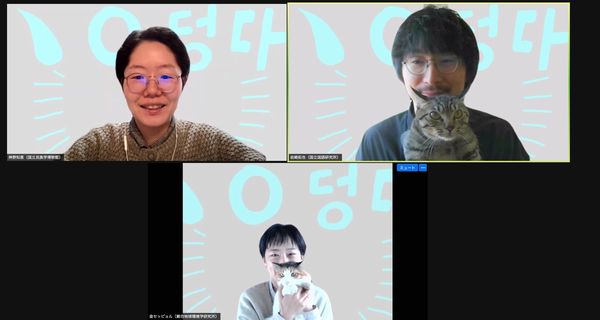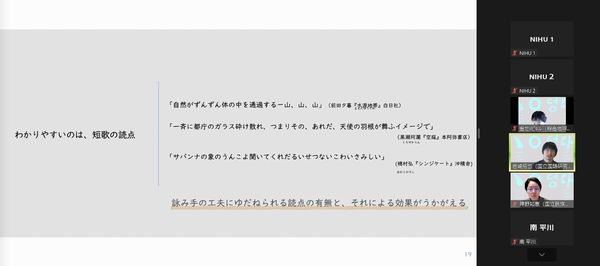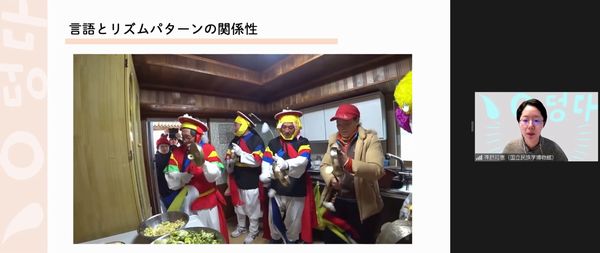Liberal Arts Communicators Live! Second Report : “ Comma, Period. Dondon, Ta!”

1.Introduction
At the Inter-University Research Institute Symposium held on October 24, 2021, we organized a live online webcast entitled, “Liberal Arts Communicators Live! A Cross-Disciplinary Research Dialogue.” This project emerged out of the idea of having liberal arts communicators, who serve as ambassadors connecting society to the field of humanities research, convey the appeal of humanities knowledge and the joys of research through a cross-disciplinary discussion from the perspective of their respective fields of expertise. In this first installment, Dr. Takuya Iwasaki, a researcher at the National Institute for Japanese Language and Linguistics, and Dr. Chie Kamino, a researcher at the National Museum of Ethnology, report on a dialogue entitled “Comma, Period. Dondon, Ta! Let’s Chat with a Punctuation Specialist and Musicologist Specializing in Korean Music!”
Although everyone uses punctuation in their own way, we can nevertheless observe certain trends. For example, there is a specific tendency that can be seen in the way punctuation is used by South Koreans who are learning Japanese. But where does this come from? It may also be related to the sense of rhythm we get from familiar music. Dr. Iwasaki, a researcher specializing in the study of punctuation, and Dr. Kamino, a musicologist specializing in Korean folk music, brought their findings from each other’s research to search for points in common. In addition, the facilitator, Dr. Satbyul Kim, a researcher at the Research Institute for Humanity and Nature, joined the discussion as someone who is herself a Korean learner of Japanese.

Screenshot 1 from the live webcast
2.The Awareness of Rhythm Apparent in Japanese Punctuation
Dr. Iwasaki, who studies Japanese-language punctuation, delivered a talk on the relationship between punctuation and rhythm in Japanese. Drawing on old textbooks and other sources, he confirmed that current punctuation conventions have been established through a varied process of trial and error. He went on to introduce the criteria for writing commas and summarized the different ways in which punctuation is written.
After presenting the four main criteria for using commas (structure, meaning, appearance, and length), he elaborated on the use of commas from lengths associated with rhythm. After pointing out that one of the most obvious examples of rhythmic commas are those found in tanka poetry, during the talk Dr. Iwasaki referred to actual tanka poems to show how the presence or absence of commas gives rise to expressive effects.
Furthermore, as Japanese people are not the only ones who use the Japanese language, he explained how punctuation is used by learners of Japanese by drawing on examples from his own research with Chinese and Korean learners of Japanese. From real-life examples, he confirmed that, whereas Chinese learners of Japanese make extensive use of both periods and comas, Korean learners of Japanese use the same number of periods as Japanese native speakers, but are extremely sparing in their use of commas. In addition, during the presentation, Dr. Iwasaki also discussed how to position commas to facilitate ease of reading, with reference to the presence or absence of statistical tendencies.
Dr. Iwasaki wrapped up his talk by summarizing the following three points, which led into the next talk by Dr. Kamino.
1)Punctuation showcases individuality (but nevertheless exhibit some common tendencies).
2)Commas serve as an indication of breathing, tempo, and rhythm.
3)In the case of language learners, the characteristics of their native language may have an influence (which could be an expression of the sense of rhythm inherent in each language).

Screenshot 2 from the live webcast
3.Rhythm in Traditional Korean Music: The Importance of Language and Breathing
Dr. Kamino has been engaged in the study of nongak (농악; literally “peasant’s music”), which is a folk performing art in South Korea. In her talk, with a view to exploring commonalities with punctuation, she began with a discussion of the essential nature of rhythm. While there are many definitions, in the context of music, at least, rhythm refers to the order created by the combination of sounds and the repetition of their cycles. Rhythm is created not only by the length of sounds, but also by their intensity, pitch, and the visual elements that accompany them.
On the Korean Peninsula, rhythm is known as jangdan (장단). From the music of the court to the nongak of the common folk, traditional Korean music consistently employs some form of jangdan, each with its own name, typical pattern, and approximate tempo. While this rhythmic culture reportedly derives from China’s Western Regions, it could be said to have developed independently along with the language used on the Korean Peninsula. The word-ending consonants known as batchim (받침) that characterize the Korean language make it more congenial for the creation of complex rhythms than Japanese. During the webcast, Dr. Kamino presented a video of a ritual featuring nongak music in which an exorcism incantation was directly linked to the rhythmic pattern of the drums.
Words and songs cannot come into being in the absence of breathing. Performances of traditional Korean music, in particular, emphasize the relationship between breathing and jangdan, and the overall structure of the music also calls for cyclical patterns of “filling and emptying,” and “tying and untying.” This aesthetic is also applied to narrative stories and writing, as well as to human relationships.
Although the punctuation marks presented by Dr. Iwasaki exist in the world of writing, Dr. Kamino proposed that these might be seen in a new light if they were to be combined with their underlying aesthetics in terms of breathing in narrative and song and the musical rhythms of each language, which led to further discussion.

Screenshot 3 from the live webcast
4.A New Discovery Arising out of Cross-Disciplinary Collaboration
While the word “punctuation” tends to be thought of more in terms of written language, which is to say writing, until modern times, at least, language and music were not as clearly separated from each other, and written texts were read aloud in a rhythmic fashion, much like spoken words or music. In light of this fact, the hypothesis that the way people use punctuation may be influenced by the rhythms of familiar music seems persuasive. The observation by one participant, that the use of the Japanese term utsu (“to strike”) with reference to punctuation suggested an affinity with percussion, seemed to speak to these findings. It was a eureka moment that could only have arisen from such cross-disciplinary collaboration.
Text: Iwasaki Takuya, Liberal Arts Communicator(National Institute for Japanese Language and Linguistics)
Kim Satbyul, Liberal Arts Communicator(Research Institute for Humanity and Nature)
Kamino Chie, Liberal Arts Communicator(National Museum of Ethnology)
